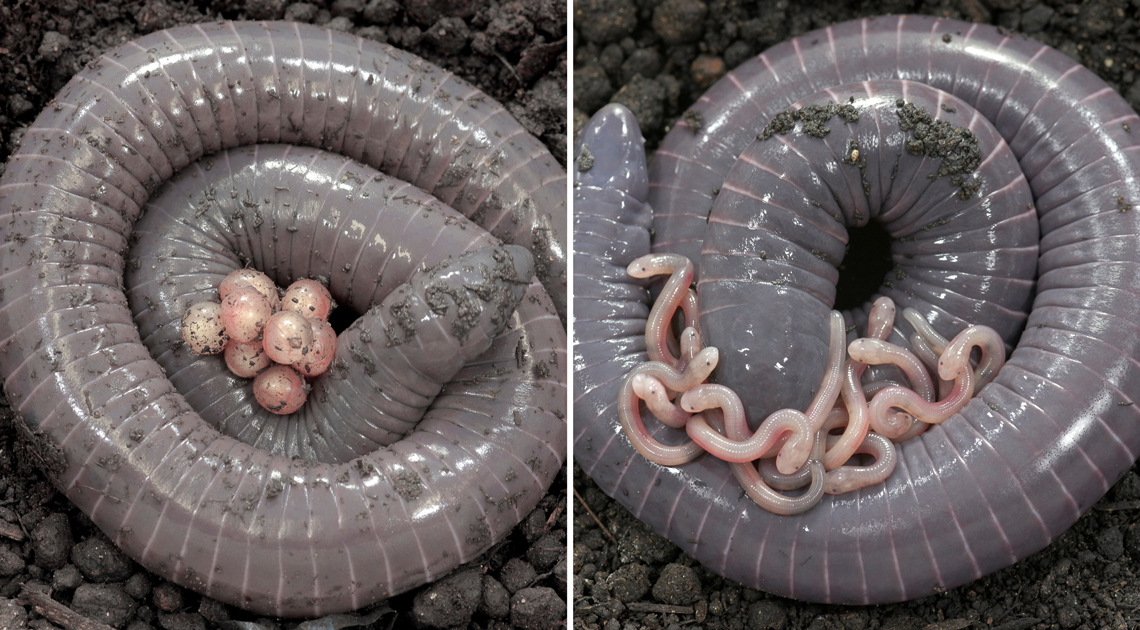In mid-2007, a film crew from the British BBC visited the Butantan Institute in São Paulo to capture footage of amphibians for its series Life in cold blood. During filming, one scene was intriguing: recently born caecilia—commonly known as blind snakes, although more similar in appearance to frogs—gathering around the mother’s cloacal opening. It was already known that the offspring feeds from a layer of maternal skin during the first months of life, but the behavior captured by the documentary aroused curiosity: what were those newborns seeking out in the opening from which they had emerged?
A team of researchers from the Butantan Institute identified the possible answer 17 years later: the offspring of Siphonops annulatus are “breastfed” daily with a kind of milk. “The mother lifts her tail and the young suckle a slightly viscous liquid expressed from the cloacal opening,” explains biologist Carlos Jared, of the Butantan Structural Biology Laboratory, author of the article describing these findings in the March edition of Science. “We collected and analyzed this liquid, and found that it has components similar to those of mammals’ milk,” says the researcher, who supervised the postdoctoral study that led to the discovery. The article goes on to describe how the young make a sound a few minutes before being fed, which may indicate their asking for food.
Few nonmammal species present this type of behavior. There are records of breastfeeding by certain types of spider, roach, fish, and birds, but the phenomenon had never been registered in egg-laying amphibians such as caecilias. The milk identified by the Butantan researchers largely comprises lipids and carbohydrates, and is secreted by glands that expand during the early parental care period of two to three months. “We cannot call them mammary glands, because the evolutionary origins are different, but this demonstrates how caecilias have adapted in different ways to survive over time,” says Jared.
To confirm their understanding of the phenomenon, the group filmed the behavior of 16 caecilia females for 242 hours over six years. The animals studied were collected in Ilhéus in northeastern Brazil’s Bahia State, a cocoa-growing region where blind snakes are commonly found underground. “As their environment is difficult to access, this is one of the lesser-known vertebrate groups in science,” says biologist Tamí Mott, of the Federal University of Alagoas (UFAL), one of few Brazilian specialists in these animals. Worldwide, 222 species of caecilia are known, of which some 20% (39) are found in Brazil. This type of animal is typical of tropical regions and depends on having moist skin, through which much of its breathing takes place.
They were described for the first time in 1822, and the Butantan group is a pioneer in the long-term study of caecilias, having discovered that the species has a poison gland at the base of its teeth, and is capable of inoculating with its bite. In 2006 the team also published an article in the journal Nature demonstrating how the young eat pieces of the mother’s external skin, modified during this early parental care period. This behavior, known as dermatophagia, or skin-feeding, has been identified in another caecilia species.
Footage of breastfeeding, however, is unprecedented, as is the sound made by the young. “There are reports of communication as a form of defense in some species, but during early parental care this is a spectacular finding,” comments Mott. For her, this work opens doors to new fronts of investigation into the evolution of these enigmatic amphibians.
Projects
1. Unraveling parental care in caecilians: Nutritional and toxinological implications in Siphonops annulatus (nº 18/03265-9); Grant Mechanism Regular Research Grant; Principal Investigator Carlos Alberto Gonçalves Silva Jared (Instituto Butantan); Investment R$175,382.65.
2. Parental care and dermatophagy in the ringed caecilian Siphonops annulatus: An integrative approach (nº 17/10488-1); Grant Mechanism Postdoctoral fellowship; Supervisor Carlos Alberto Gonçalves Silva Jared (Instituto Butantan); Beneficiary Pedro Luiz Mailho Fontana; Investment R$310,331.44.
Scientific articles
MAILHO-FONTANA, P. L. et al. Milk provisioning in oviparous caecilian amphibians. Science. Online. Mar. 8, 2024.
KUPFER, A. M. et al. Parental investment by skin feeding in a caecilian amphibian. Nature. Vol. 440, pp. 926–9. Apr. 13, 2006.

